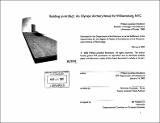| dc.contributor.advisor | Fernando Domeyko. | en_US |
| dc.contributor.author | Braddock, William Jonathan, 1977- | en_US |
| dc.contributor.other | Massachusetts Institute of Technology. Dept. of Architecture. | en_US |
| dc.coverage.spatial | n-us-ny | en_US |
| dc.date.accessioned | 2006-03-24T18:31:59Z | |
| dc.date.available | 2006-03-24T18:31:59Z | |
| dc.date.copyright | 2005 | en_US |
| dc.date.issued | 2005 | en_US |
| dc.identifier.uri | http://hdl.handle.net/1721.1/30226 | |
| dc.description | Thesis (M. Arch.)--Massachusetts Institute of Technology, Dept. of Architecture, 2005. | en_US |
| dc.description | Includes bibliographical references (leaves 62-63). | en_US |
| dc.description.abstract | Every four years, cities throughout the world compete for the right to host the Olympic games. The competition is vigorous because the rewards in terms of increased visibility on the world stage, are perceived to be great. For many cities, hosting the Olympics means more than just introducing the most prestigious and exciting sporting event to the world but it offers the prospect of new athletic facilities, infrastructure and a new identity. In the summer of 2005, New York City will learn whether it has been selected as the host city for the 2012 Summer Olympics. It is in competition with 3 other cities that all maintain a current prominence on the international stage and all have a master plan to distinguish themselves. For New York, the strategy is to distribute the venues around the boroughs in an effort to stimulate growth and development in some of it's most critical areas. This plan makes it possible for neighborhoods within the overall urban context of the city to benefit from the tourism and economic trigger that the Olympic games will bring. It also provides the opportunity for these neighborhoods, some of which have been cut off from the city due to poorly maintained infrastructure and little or no access to be reconnected. This thesis is an attempt to magnify the master plan of the New York City 2012 Olympic proposal to the scale of a neighborhood in Williamsburg. It identifies the East River Waterfront as the site of specificity and proposes to design an artifact for the community using the archery venue as a programmatic generator. | en_US |
| dc.description.statementofresponsibility | William Jonathan Braddock. | en_US |
| dc.format.extent | 63 leaves | en_US |
| dc.format.extent | 1987929 bytes | |
| dc.format.extent | 1994139 bytes | |
| dc.format.mimetype | application/pdf | |
| dc.format.mimetype | application/pdf | |
| dc.language.iso | eng | en_US |
| dc.publisher | Massachusetts Institute of Technology | en_US |
| dc.rights | M.I.T. theses are protected by copyright. They may be viewed from this source for any purpose, but reproduction or distribution in any format is prohibited without written permission. See provided URL for inquiries about permission. | en_US |
| dc.rights.uri | http://dspace.mit.edu/handle/1721.1/7582 | |
| dc.subject | Architecture. | en_US |
| dc.title | Building an artifact : an Olympic archery venue for Williamsburg, NYC | en_US |
| dc.type | Thesis | en_US |
| dc.description.degree | M.Arch. | en_US |
| dc.contributor.department | Massachusetts Institute of Technology. Department of Architecture | |
| dc.identifier.oclc | 60803700 | en_US |
